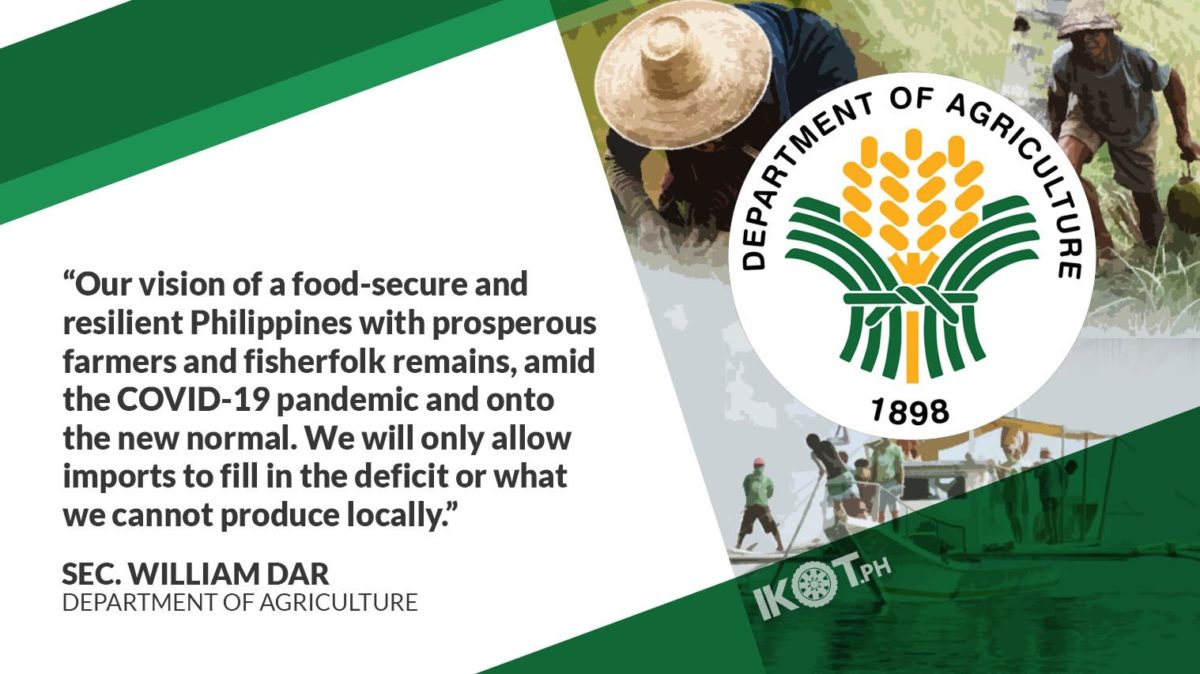Agriculture Secretary William Dar said the Duterte administration continues to put a premium on protecting the interests and welfare of the Filipino farmers and fishers, and that sourcing additional food commodities from other countries amid the coronavirus disease (COVID-19) pandemic remains a “last resort” policy.
“Our vision of a food-secure and resilient Philippines with prosperous farmers and fisherfolk remains, amid the COVID-19 pandemic and onto the new normal. We will only allow imports to fill in the deficit or what we cannot produce locally,” Dar stressed.
The agriculture chief issued the statement to debunk criticisms and perceptions that the current Department of Agriculture (DA) leadership “made the country food import-dependent” despite abundant land and sea resources capable of producing most of the food requirements of 110 million Filipinos.
“The country’s dependency on imported food has been increasing during the past 30 years.”
In fact, the agriculture head said the country’s dependency on imported food has been increasing during the past 30 years, according to the Philippine Statistics Authority (PSA).
In 2016, import-dependency was at 22.5%, which slightly inched up to 22.7% in 2017, and jumped to 29.2% in 2018 – as local food production was not able to keep pace with population growth during that three-year period, the PSA said.
In fact, based on PSA’s food balance sheets (FBS), the country’s self-sufficiency ratio (SSR) for aggregated food commodities fell to 79.4% in 2018 from 83.2% in 2016, and to 86.8% in 2017.
The FBS provides a comprehensive picture of the country’s food supply during a specified reference period and provides an indication of the adequacy of food supply relative to the nutritional requirement of the population.
Increased food importation saw an annual per capita increase in the supply and consumption of cereals, meat, and sources of fat and protein.
PSA figures also show that the country has been importing several major food items, as a percentage of total national requirement, at varying rates: rice (14%), corn (12%), pork (14%), dressed chicken (6%), beef (39%), onions (38%), garlic (91%), coffee (71), and, peanut (75%).
This was backed by Dr. Fermin Adriano, former information director of the University of the Philippines System and vice-chancellor of the University of the Philippines Los Baños. Adriano said that low farm productivity should be blamed for the shortfall, as it has not kept pace with the population growth rate.
“While our population growth during the last decade, from 2008 to 2018, averaged around 1.7% to 1.8%, our agricultural sector grew an annual average of only 1.3% for the same period,” he said.
Clearly, there is a big gap, hence the country has been importing additional food to feed the growing population.
“In economic parlance, this is a simple case of local demand outstripping local supply. Thus, importation is a necessary recourse to ensure that our people will not go hungry,” Adriano said.
“The DA is investing heavily in the modernization and industrialization of Philippine agriculture, which are the cornerstones of his eight-point paradigm shift.”
Nevertheless, to meet the food requirements of the Filipino people, especially at this time of the pandemic, Dar said that the DA is investing heavily in the modernization and industrialization of Philippine agriculture, which are the cornerstones of his eight-point paradigm shift.
The DA’s “new thinking” in agricultural development veers away from the heavy focus on specific crops towards improving overall resilience, competitiveness, and sustainability of the rural sector.
“Realizing this vision will require dedicated efforts among major agri-fishery industry stakeholders, led by the DA, to continuously empower farmers, fisherfolk, and entrepreneurs, and for the private sector to help increase farm productivity and profitability, taking into account sustainability and resilience,” he concluded.

